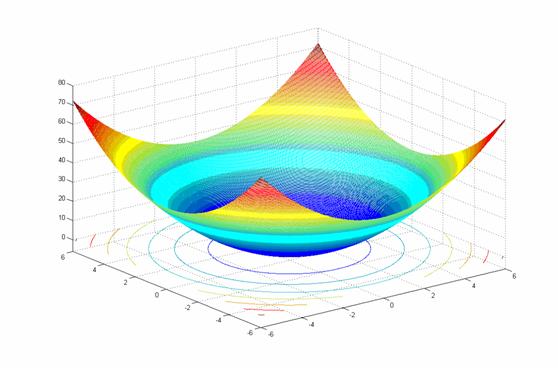

Some features of the framework will not work, like some report Adapters, however, the PSO core is working really great. I've used the PyPSO subversion release 0.11. Since it's not finished yet, you can download from the subversion repository from here.
Here is the source code I've used to minimize the De Jong's Sphere function (Special thanks to Christian Perone who inspired me to do this work) :
"""
PyPsoS60Demo.py
Author: Marcel Pinheiro Caraciolo
caraciol@gmail.com
License: GPL3
"""
BLUE = 0x0000ff
RED = 0xff0000
BLACK = 0x000000
WHITE = 0xffffff
import e32, graphics, appuifw
print "Loading PyPSO modules... ",
e32.ao_yield()
from pypso import Particle1D
from pypso import GlobalTopology
from pypso import Pso
from pypso import Consts
img = None
coords = []
graphMode = False
canvas = None
w = h = 0
print " done !"
e32.ao_yield()
def handle_redraw(rect):
if img is not None:
canvas.blit(img)
def sphere(particle):
total = 0.0
for value in particle.position:
total += (value ** 2.0)
return total
def pso_callback(pso_engine):
it = pso_engine.getCurrentStep()
best = pso_engine.bestParticle()
if graphMode:
img.clear(BLACK)
img.text((5, 15), u"Iteration %d - Best Fitness: %.2f" % (it,best.ownBestFitness), WHITE, font=('normal', 14, appuifw.STYLE_BOLD))
img.line((int(w/2),0,int(w/2),h),WHITE)
img.line((0,int(h/2),w,int(h/2)),WHITE)
cx = int(w/2) / int(best.getParam("rangePosmax"))
cy = int(-h/2) / int(best.getParam("rangePosmax"))
for particle in pso_engine.topology:
img.point([int(cx*particle.position[0]+ (w/2)),int(cy*particle.position[1]+(h/2)),5,5],BLUE,width=4)
img.point([int(cx*best.ownBestPosition[0]+ (w/2)),int(cy*best.ownBestPosition[1]+(h/2)),5,5],RED,width=4)
handle_redraw(())
else:
print "Iteration %d - Best Fitness: %.2f" % (it, best.ownBestFitness)
e32.ao_yield()
return False
def showBestParticle(best):
global graphMode
if graphMode:
img.clear(BLACK)
img.text((5, 15), u"Best particle fitness: %.2f" % best.ownBestFitness, WHITE, font=('normal', 14, appuifw.STYLE_BOLD))
img.line((int(w/2),0,int(w/2),h),WHITE)
img.line((0,int(h/2),w,int(h/2)),WHITE)
cx = int(w/2) / int(best.getParam("rangePosmax"))
cy = int(-h/2) / int(best.getParam("rangePosmax"))
img.point([int(cx*best.ownBestPosition[0]+ (w/2)),int(cy*best.ownBestPosition[1]+(h/2))],RED,width=7)
handle_redraw(())
e32.ao_sleep(4)
else:
print "\nBest particle fitness: %.2f" % (best.ownBestFitness,)
if __name__ == "__main__":
global graphMode, canvas, w, h
data = appuifw.query(u"Do you want to run on graphics mode ?", "query")
graphMode = data or False
if graphMode:
canvas = appuifw.Canvas(redraw_callback=handle_redraw)
appuifw.app.body = canvas
appuifw.app.screen = 'full'
appuifw.app.orientation = 'landscape'
w,h = canvas.size
img = graphics.Image.new((w,h))
img.clear(BLACK)
handle_redraw(())
e32.ao_yield()
#Parameters
dimmensions = 5
swarm_size = 30
timeSteps = 100
particleRep = Particle1D.Particle1D(dimmensions)
particleRep.setParams(rangePosmin=-5.12, rangePosmax=5.13, rangeVelmin=-5.12, rangeVelmax=5.13, bestFitness= 0.0 ,roundDecimal=2)
particleRep.evaluator.set(sphere)
topology = GlobalTopology.GlobalTopology(particleRep)
pso = Pso.SimplePSO(topology)
pso.setTimeSteps(timeSteps)
pso.setPsoType(Consts.psoType["CONSTRICTED"])
pso.terminationCriteria.set(Pso.FitnessScoreCriteria)
pso.stepCallback.set(pso_callback)
pso.setSwarmSize(swarm_size)
pso.execute()
best = pso.bestParticle()
showBestParticle(best)
To make things more interesting, i've decided to put a simple graphic mode, when the user can choose to see the simulation in graphics mode or console mode. So as soon as you start the PyPsoS60Demo.py script, a dialog will show up to ask which mode the user prefer to see the simulation. You can see the video of the graphics mode running below.
Each point is a particle and they're updating their position through the simulation and since the best optimal solution of the problem is the point (0,0), in the end of the simulation, the particles will be close to the best solution. You can see that the red point is the best particle of all swarm.
You can note at the source code the use of the module "e32" of the PyS60, this is used to process pending events, so we can follow the statistics of the current iteration while it evolves.
I hope you enjoyed this work, the next step is to port the Travelling Salesman Problem to cellphone!
You can download the script above here.
Marcel Pinheiro Caraciolo


![PythonBrasil[9]](http://2013.pythonbrasil.org.br/divulgue/no-seu-site/pythonbrasil9_en_halfbanner.gif)






Hi,Amazing post!
ReplyDeleteI see that you are interested about Particle swarm optimization.
I found one great book about it here: http://www.intechopen.com/books/show/title/particle_swarm_optimization
It is free to download!!
Some chapters are: Swarm Intelligence Applications in Electric Machines, Search Performance Improvement for PSO in High Dimensional Space, Swarm Intelligence in Portfolio Selection etc.
Hope you will enjoy it!
Nice Blog , This is what I exactly Looking for , Keep sharing more blog .
ReplyDeleteSpark Training Academy Chennai
Amazing content.
ReplyDeleteData Mining Service Providers in Bangalore
I have read your blog its very attractive and impressive. I like it your blog.
ReplyDeleteviraltrench
This professional hacker is absolutely reliable and I strongly recommend him for any type of hack you require. I know this because I have hired him severally for various hacks and he has never disappointed me nor any of my friends who have hired him too, he can help you with any of the following hacks:
ReplyDelete-Phone hacks (remotely)
-Credit repair
-Bitcoin recovery (any cryptocurrency)
-Make money from home (USA only)
-Social media hacks
-Website hacks
-Erase criminal records (USA & Canada only)
-Grade change
-funds recovery
Email: onlineghosthacker247@ gmail .com
هل سهم شمس حلال؟
ReplyDeleteتعتبر شركة المشروعات السياحية، المعروفة اختصارًا باسم “شمس”، واحدة من أبرز الشركات